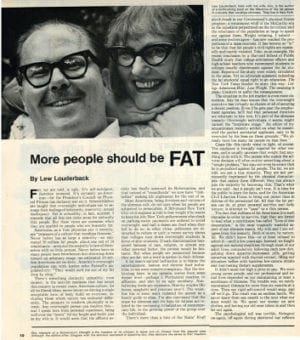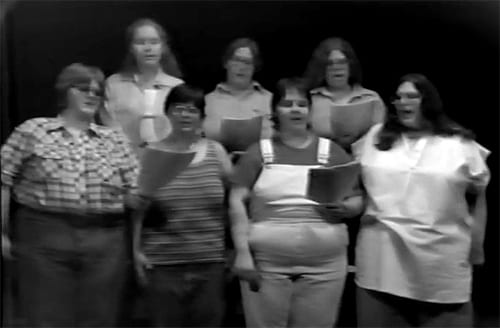Where did the fat acceptance movement start? Who started it? And how is it related to body positivity, Health at Every Size®, and Intuitive Eating, anyway?
We seem to be in the midst of a cultural shift. The diet industry is still extremely profitable, raking in billions of dollars each year in the United States alone (and yes, that’s billions, with a b), but a resistance is forming. It’s happening on Instagram, on YouTube, in closed Facebook groups, in bookstores. And it’s going by many names: Health at Every Size, Intuitive Eating, anti-diet, body positivity, body liberation. But what all of these things have in common is that they are all rooted in a movement that began in the 1960s called fat acceptance.
The Origins of the Fat Acceptance Movement
Like any good countercultural movement from the 1960s, it all started with a sit-in. Or, rather, a “fat-in.” In 1967, 500 people came together in Central Park in New York City to protest bias against fat people. Together, this group ate, carried signs of protest, burned diet books and photos of model Twiggy, and were visibly, publicly, and loudly fat without being apologetic. And that same year, a man named Llewelyn “Lew” Louderback wrote an article for the Saturday Evening Post titled, “More People Should be FAT,” in response to the discrimination his wife faced. This was one of the first public defenses of fatness in the mainstream.

Image of Lew Louderback’s article for the Saturday Evening Post.
This article led to a meeting with William Fabrey, and that led to the formation of the first group that sought to address discrimination against fat people. Louderback would go on to author a book called Fat Power: Whatever You Weigh Is Right.
National Association to Advance Fat Acceptance (NAAFA)
Originally called the “National Association to Aid Fat Americans” when it was founded in 1969, NAAFA was groundbreaking in addressing weight bias and discrimination against fat people as a civil rights issue. In their early days, they focused on letter-writing campaigns and providing a social network for its members, which included fat people as well as those who were attracted to fat people. NAAFA began holding an annual conference, which allowed fat people to meet, dance, celebrate, find community, and even find romance.
The NAAFA conference is still an important event for the fat acceptance movement, though NAAFA as an organization has evolved into a more explicitly political force. The organization changed its name to “National Association to Advance Fat Acceptance” in the 1980s. To this day, NAAFA is an important resource on the discrimination fat people face in society, focusing on bias in healthcare, employment, and education. They provide resources to help fat people self-advocate, as well advocating to make weight a protected class, offering fat people some degree of legal protection from discrimination.
The Fat Underground and the Fat Liberation Manifesto

Still from a video featuring members of the Fat Underground.
A collective of women in Los Angeles came together and formed the Fat Underground. Their form of activism was more confrontational than NAAFA’s, informed by second wave feminists and gay activism of the 1970s. (Indeed, many of its members were radical feminists and lesbians.) The Fat Underground began as a more radical and activism-minded chapter of NAAFA, but eventually split from the parent organization. Judy Freespirit and Sara Aldebaran published their “Fat Liberation Manifesto” in response to Susie Orbach’s book Fat is a Feminist Issue in the April 1979 issue of Off Our Backs, a radical feminist magazine:
We believe that fat people are fully entitled to human respect and recognition. We are angry at the mistreatment by commercial and sexist interests. These have exploited our bodies as objects of ridicule, thereby creating an immensely profitable market selling the false promise of avoidance of, or relief from, that ridicule. We see our struggle as allied with the struggle of other oppressed groups, against classism, racism, sexism, ageism, capitalism, imperialism, and the like.
The Fat Underground was closely aligned with the Radical Therapy Collective. Some members of the Fat Underground were also members of this collective, that believed that many psychological issues were the product of societal oppression. Have you heard the phrase, “Diets are a cure that doesn’t work, for a disease that doesn’t exist?” That’s a phrase coined by the Fat Underground. The Fat Underground would later collaborate with the New Haven Fat Liberation Front on a classic fat activism book called Shadow on a Tightrope, which compiled personal essays, articles, and poems by fat women and activists.
Fat Acceptance and Feminism
Much of the focus in fat activism has been on the oppression of fat women in particular. This can be traced back to the fat acceptance movement’s ties to feminism’s radical second wave, as well as the fact that NAAFA and early fat activism was spearheaded by men but focused on the discrimination their wives experienced. Many early fat activists believed that diet culture was a tool of patriarchal oppression, used to exert control over women’s bodies and lives. Modern fat activism is still primarily lead by and focused on women, but aims to be more inclusive of men and nonbinary people.
The Fatosphere: Fat Acceptance Through the 1990s
The fat acceptance movement has its roots in 1960s activism, but in the late 1980s and early 1990s, evolved with the times. The movement moved into self-published zines like Marilyn Wann’s Fat!So? (which was later compiled into a book of the same time), blogs, and listservs, allowing people to connect beyond conferences and in-person meetings. Notable fat activists in “the fatosphere” include Kate Harding and Marianne Kirby, who collaborated on the book Lessons from the Fat-o-sphere.
In the academic world, Fat Studies became a legitimate field of study, with universities throughout the United States offering at least one Fat Studies course. In 2008, Esther Rothblum and Sondra Solovay worked to edit the Fat Studies Reader, compiling the articles, personal essays, studies and work of fat activists from previous decades into a tome preserving the cornerstones of the fat acceptance movement.
Health at Every Size® and Intuitive Eating
Health at Every Size (HAES) is now something of a buzzword, and a concept that registered dietitians and clinicians who treat eating disorders like anorexia are embracing with open arms. However, it has its roots in the fat, queer, feminist rebellion of groups like the Fat Underground. The trademark for the term is owned by the Association for Size Diversity and Health (ASDAH), but the origins of Health at Every Size are older than ASDAH by decades. And while Lindo Bacon’s book 2008 book Health at Every Size: The Surprising Truth About Your Weight is often credited with creating the movement, it is a movement that has been building since that seminal Central Park “fat-in” in the 1960s. Intuitive Eating was popularized by the book by Evelyn Tribole and Elyse Resch, but the anti-diet concept dates back to Susie Orbach’s 1978 book Fat is a Feminist Issue (which dealt with “compulsive eating”), which helped inspire The Fat Liberation Manifesto.
Health at Every Size takes the core tenets of the fat acceptance movement, coined by radical fat activists, and applies them to a weight-neutral approach to healthcare. The ideas behind HAES as a movement were painstakingly advanced by fat activists over the course of decades, which is important to remember as these concepts go mainstream. Intuitive Eating and the “anti-diet” approach are offshoots of the work these activists did to question the conventional wisdom around how we eat. As these concepts become more widely known, it is not unusual for their tenets to be co-opted by diet culture. Remember that social justice and discrimination against fat people are at the heart of HAES and Intuitive Eating, so it’s vital that these movements not exclude the very people they were created by and for.
Health at Every Size® and HAES® are registered trademarks of the Association for Size Diversity and Health
